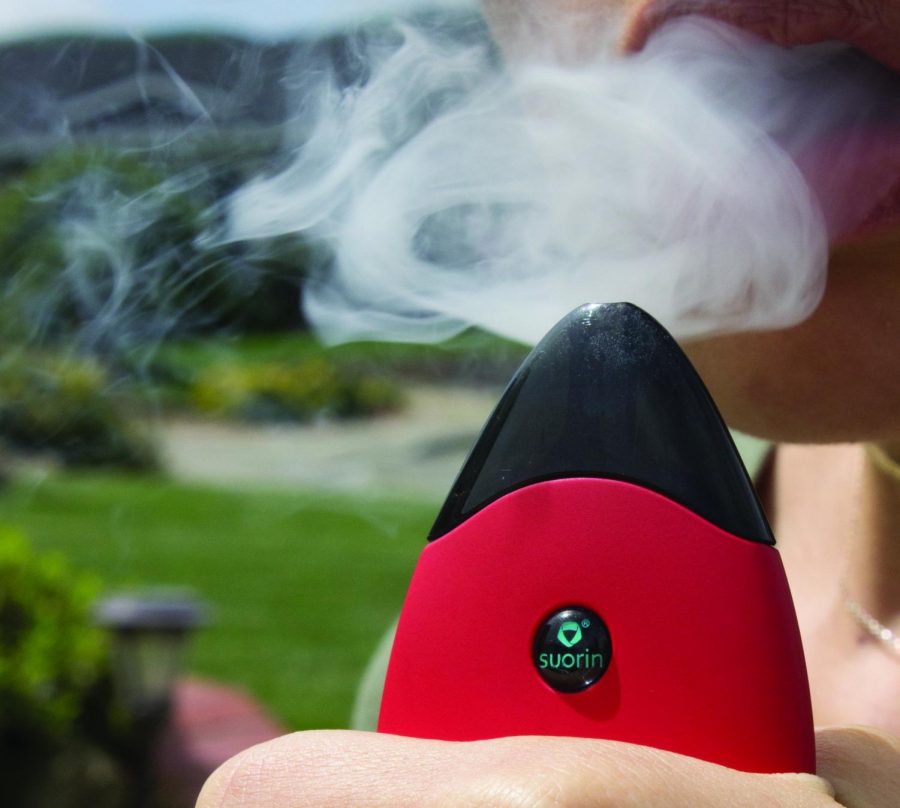Anti-vaping class implemented
Saturday program tried instead of suspensions
Californian file photo by Abby Fritz
Vaping reamins a serious concern in Cal High.
The vaping craze is sweeping the nation, and Cal High is no exception.
To combat this, the school district has implemented a program called Saturday Vape Alternative to Suspension Class.
Suggested by Cal High assistant principal Catie Hawkins,the class helps educate students about the dangers of tobacco and nicotine.
The district began offering the classes last spring for students who are caught vaping on campus. Instead of immediately punishing students by suspending them and having them miss school, the class aims to educate and rehabilitate students, Hawkins said.
“Having a student be removed from school really wasn’t educating them on what happens and possibilities of what can happen when you vape,” said Hawkins.
When Hawkins first started teaching at Cal in the mid-2000s, there was a smoking cessation class where first-time smoking offenders were educated on the issue of nicotine addiction, rather than punished. This helped inspire Hawkins to suggest the anti-vaping program.
The anti-vaping class is one Saturday a month from 8:30 a.m. to 12:30 p.m., and rotates between different high schools in the district, said assistant principal Bob Spain.
The class instructor, who is a teacher at the school where the class is offered that month, informs students about how quickly nicotine, and drugs in general, can become an addiction, said Spain.
Cal health teacher Joe Sussman, who used to teach the smoking cessation class, has been one of the instructors for the anti-vaping program.
Sussman describes the vape companies as brilliant yet disastrous. He said teenagers are drawn to vaping because it’s a new, different, high tech industry, especially when compared to simply smoking.
“The message [of the class] is obviously that nicotine is addictive and shouldn’t be used by anyone, but particularly students,” said Spain.
Spain believes that students often vape in the bathrooms because they think they have a lesser chance of being caught.
“Vaping occurs mainly in the all-gender and fine arts bathrooms, and leaves little smoke,” said sophomore Mikayla Abadir.
The fact that vape pens create little to no smoke or smell is only further encouragement for students to vape freely. Some students even go as far as to vape during class when they think the teacher isn’t looking.
“Vapers also use the parking lot often, as well as the commons bathroom,” said sophomore Jude Lee.
Lee also believes that the vast amount of vapers constantly in the all-gender bathroom discourages people who actually need to use it.
But vaping isn’t specific to Cal. It’s a dangerous habit that many teenagers across the country participate in. This is because vape companies advertise to teenagers in a similar way cigarette companies used to, without informing them of the risks.
Vape companies do this by using flavors and advertisements that appeal to students of many different ages, reaching those as young as middle school.
“It’s no surprise that vaping is a huge issue at Cal and high schools throughout the nation,” said Spain.
E-liquid itself, which is what is in vape pens, is practically tasteless. But there’s an extensive variety of flavors, some harmful, that attracts much of America’s youth to the industry.
The anti-vaping class aims to show students that the vape companies are exploiting them, and starting their lifelong battles with addiction, which, until recently had been caused by cigarettes.
The original purpose of vaping was to help people quit smoking. Studies show that vape liquid contains enough nicotine to keep the consumer satisfied, but not as much as cigarettes. Vaping is often viewed as a harmless trend without any health-related consequences.
Once the class makes them aware of the ramifications of vaping, administrators hope that students will find it in their best interest to quit.
The district hopes that this class will defer students from vaping, thereby protecting them from the health consequences that go along with it.

Emmy Burrus is a senior at California High School, and is entering her third year of being a part of the Californian staff as Co Editor-in-Chief. Last...







Debra Klevens • Oct 31, 2018 at 8:31 am
Do you have any data showing whether or not this is serving as a deterrent yet or not? I would love to share this with our school district.
Brian Barr • Oct 31, 2018 at 10:21 am
It just started, so we probably won’t have a better idea until later in the school year. We plan to follow up, but if you’d like to see if there is anything now I suggest you contact one of our assistant principals, Andy Briggs, at [email protected]. Catie Hawkins would be a good contact as well at [email protected].